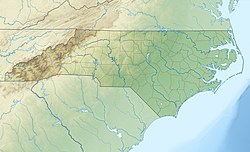Cow Branch Formation
| Cow Branch Formation Stratigraphic range: Carnian-Norian (Tuvalian) ~ | |
|---|---|
 Cow Branch Formation (Upper Triassic; near Eden, North Carolina) | |
| Type | Geological formation |
| Unit of | Dan River Group |
| Location | |
| Coordinates | 36°24′N 80°00′W / 36.4°N 80.0°WCoordinates: 36°24′N 80°00′W / 36.4°N 80.0°W |
| Approximate paleocoordinates | 5°30′N 20°24′W / 5.5°N 20.4°W |
| Region | Virginia |
| Country | |
 Cow Branch Formation (the United States) | |

Outcrop of the Cow Branch Formation, quarry near Eden, North Carölina

Fossils in black shales of the Cow Branch Formation

Fossil fish spine in black shale of the Cow Branch Formation, North Carolina

Vertebrate tooth in nonmarine black shale, Cow Branch Formation, North Carolina
The Cow Branch Formation is a Late Triassic (Carnian to Norian, or Tuvalian in the regional stratigraphy) geologic formation in the eastern United States.[1] Indeterminate fossil ornithischian tracks have been reported from the formation.[2]
Fossil content[]
The following fossils have been reported from the formation:[1]
- Reptiles
- Fish
- Diplurus cf. newarki
- Semionotus sp.
- Turseodus sp.
- Ichnofossils
- Anchisauripus milfordensis
- Arachnids
- Insects
- [4]
- [5]
- [6]
- [7]
- Archescytinidae indet.
- Blattodea indet.
- Diptera indet.
- Naucoridae indet.
- Orthoptera indet.
- Thysanoptera indet.
- Tipulomorpha indet.
- Flora
See also[]
| Wikimedia Commons has media related to Category:Cow Branch Formation. |
- List of dinosaur-bearing rock formations
- List of stratigraphic units with ornithischian tracks
- Indeterminate ornithischian tracks
- List of stratigraphic units with ornithischian tracks
References[]
- ^ a b Cow Branch Formation at Fossilworks.org
- ^ Weishampel et al., 2004, pp.517-607
- ^ Selden et al., 1999
- ^ Fang et al., 2018
- ^ Kelly et al., 2017
- ^ Huber et al., 2003
- ^ Criscione & Grimaldi, 2017
Bibliography[]
- ; ; ; , and . 2018. The earliest Elcanidae (Insecta, Orthoptera) from the Upper Triassic of North America. Journal of Paleontology 92. 1028–1034.
- , and . 2017. The oldest predaceous water bugs (Insecta, Heteroptera, Belostomatidae), with implications for paleolimnology of the Triassic Cow Branch Formation. Journal of Paleontology 91. 1166–1177.
- ; , and . 2017. Mesozoic Holcoptera (Coleoptera: Coptoclavidae) from England and the United States. Proceedings of the Geologists' Association 128. 659–674.
- ; , and . 2007. How time flies for flies: diverse Diptera from the Triassic of Virginia and early radiation of the order. American Museum Novitates 3572. 1–39.
- ; , and . 2004. The Dinosauria, 2nd edition, 1–880. Berkeley: University of California Press. Accessed 2019-02-21. ISBN 0-520-24209-2
- . 2003. Early Jurassic insects from the Newark Supergroup, northeastern United States. In P. M. LeTourneau, P. E. Olsen (eds.). The Great Rift Valleys of Pangea in Eastern North America 2: Sedimentology, Stratigraphy, and Paleontology. 206–223.
- ; ; , and . 1999. Fossil araneomorph spiders from the Triassic of South Africa and Virginia. The Journal of Arachnology 27. 401–414.
- . 1979. A new aquatic eosuchian from the Newark Supergroup (Late Triassic–Early Jurassic) of North Carolina and Virginia. Postilla 176. 1–14.
- ; ; , and . 1978. Cyclic change in Late Triassic lacustrine communities. Science 201. 729–733.
Categories:
- Geologic formations of North Carolina
- Geologic formations of Virginia
- Triassic System of North America
- Triassic geology of North Carolina
- Triassic geology of Virginia
- Carnian Stage
- Norian Stage
- Shale formations of the United States
- Siltstone formations
- Lacustrine deposits
- Ichnofossiliferous formations
- Paleontology in North Carolina
- Paleontology in Virginia

